function agglomerativeHierachicalClustering( data, costFunction, targetClusters ) {
// Let's keep track of the number of clusters, which initially is the total
// number of data points. Additionally, for each data point, let's track
// the cluster with which it belongs. This is O(n).
let n = data.length;
let clusterCount = n;
let clustersByDataIndex = Array.from( Array( n ).keys()).map( i => new Set( [ i ] ) );
// Next, let's call the user defined cost function to determine the distances
// between each point. Note that this will compute the cost of data point i
// to j, but not j to i. This is O(n^2). Then, sort the costs from low to
// high, in preparation for agglomerating the data points. This is O(n log n).
let costMatrix = [];
for ( let i = 0; i < n; i++ ) {
for ( let j = i + 1 ; j < n; j++ ) {
costMatrix.push( {dataIndex: { i: i, j: j }, cost: costFunction( data[ i ], data[ j ] ) } );
}
}
costMatrix.sort( ( a, b ) => a.cost - b.cost );
// Simply walk the sorted cost matrix, combining the points that are closest
// to each other into sets of data points, adjusting the cluster count as the
// sets are combined. This is between O(n) and O(n^2).
for ( i = 0; i < costMatrix.length; i++ ) {
if ( clusterCount <= targetClusters ) {
break;
}
let cm = costMatrix[ i ].dataIndex;
if ( clustersByDataIndex[ cm.i ] !== clustersByDataIndex[ cm.j ] ) {
for ( let s of clustersByDataIndex[ cm.j ] ) {
clustersByDataIndex[ cm.i ].add( s );
clustersByDataIndex[ s ] = clustersByDataIndex[ cm.i ];
}
clusterCount--;
}
}
// Finally, reduce the cluster index to unique clusters and return the result.
return [ ...new Set( clustersByDataIndex ) ];
}
myData = [
{ name: 'A', x:20, y:40},
{ name: 'B', x:30, y:35},
{ name: 'C', x:35, y:45},
{ name: 'D', x:40, y:40},
{ name: 'E', x:55, y:20},
{ name: 'F', x:05, y:25},
{ name: 'G', x:10, y:05},
{ name: 'H', x:60, y:00}
];
console.log( 'The data points are...' );
console.log( myData );
function myCost( a, b ) {
return Math.abs( ( b.x - a.x ) ** 2 + ( b.y - a.y ) ** 2 );
}
let result = agglomerativeHierachicalClustering( myData, myCost, 3 );
console.log( 'The clusters are...' );
for ( let i = 0; i < result.length; i++ ) {
console.log( [ ...result[ i ] ].map( x => myData[ x ].name) );
}
